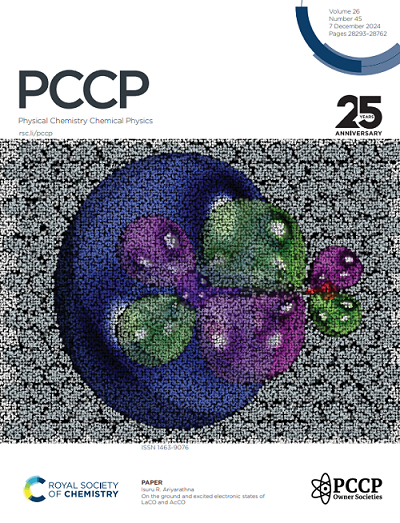含伪冠醚的大环C,C′-二芳基-邻碳硼烷衍生物:阳离子识别后的发射增强
IF 2.9
3区 化学
Q3 CHEMISTRY, PHYSICAL
引用次数: 0
摘要
本研究报道了大环C,C′-二芳基-邻碳硼烷衍生物的聚集诱导发射(AIE)性质,以及通过添加阳离子调节激发态结构弛豫来调节其发光性质。我们通过将低聚(乙二醇)链与v型二烷基-邻碳硼烷单元结合,合成了邻碳硼烷系链大环。结果表明,溶液中阳离子的识别可以诱导大环的发射增强,并且最大发射波长的异色偏移程度显著取决于阳离子的大小。光物理动力学分析表明,阳离子络合通过限制分子内运动抑制了非辐射衰变过程。本文章由计算机程序翻译,如有差异,请以英文原文为准。

Macrocyclic C,C′-diaryl-o-carborane derivatives containing pseudo-crown ether: emission enhancement upon cation recognition†
We report the aggregation-induced emission (AIE) properties of macrocyclic C,C′-diaryl-o-carborane derivatives and modulation of the luminescence properties by adding cations through the regulation of excited-state structural relaxation. It was demonstrated that the emission enhancement and suppression of the non-radiative decay process can be induced upon cation recognition.
求助全文
通过发布文献求助,成功后即可免费获取论文全文。
去求助
来源期刊

Physical Chemistry Chemical Physics
化学-物理:原子、分子和化学物理
CiteScore
5.50
自引率
9.10%
发文量
2675
审稿时长
2.0 months
期刊介绍:
Physical Chemistry Chemical Physics (PCCP) is an international journal co-owned by 19 physical chemistry and physics societies from around the world. This journal publishes original, cutting-edge research in physical chemistry, chemical physics and biophysical chemistry. To be suitable for publication in PCCP, articles must include significant innovation and/or insight into physical chemistry; this is the most important criterion that reviewers and Editors will judge against when evaluating submissions.
The journal has a broad scope and welcomes contributions spanning experiment, theory, computation and data science. Topical coverage includes spectroscopy, dynamics, kinetics, statistical mechanics, thermodynamics, electrochemistry, catalysis, surface science, quantum mechanics, quantum computing and machine learning. Interdisciplinary research areas such as polymers and soft matter, materials, nanoscience, energy, surfaces/interfaces, and biophysical chemistry are welcomed if they demonstrate significant innovation and/or insight into physical chemistry. Joined experimental/theoretical studies are particularly appreciated when complementary and based on up-to-date approaches.
 求助内容:
求助内容: 应助结果提醒方式:
应助结果提醒方式:


